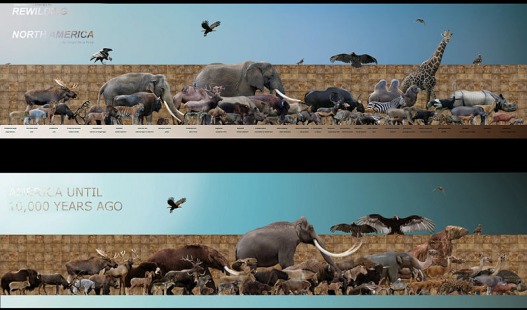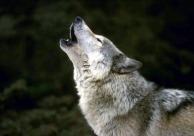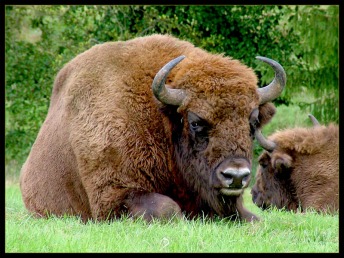[email protected]
Pleistocene Rewilding - Lions and Elephants in U.S.A.

A rather new and controversial idea is circulating in the universe. A group of conservation biologists proposed to populate western North America with African and Asian megafauna, including lions, elephants, cheetahs, and camels, to create a facsimile of a species assemblage that disappeared from the continent some 13,000 years ago (Rubenstein et al., 2006). During the Pleistocene most of these large vertebrates died out , when humans from Eurasia began migrating to the continent (Donlan, 2007). Subsequently, one can think that humans have the moral responsability to bring back the evolutionary and ecological potential that our ancestors destroyed in the pleistocene (Rubenstein et al., 2006). Besides ethics, this concepts, of course, has a scientifically substantiated base. The founder of the Pleistocene Rewilding concept, Paul Martin (2005), states that present ecological communities in North America do not function appropriately in the absence of megafauna because many plant and animal species evolved under the influence of large mammals. Adherents believe that the introduction of megafauna holds the potential to reestablish key ecological processes, such as predation and browsing, that once thrived there and thus could promote biodiversity (Donlan, 2007). Thereby, the concept also occupies the conservation field much wider by directly providing a refuge for the often highly endangered species from Africa and Asia. However, this concept makes the rather debatable assumption that communities today are ecologically similar to communities in the Pleistocene 13,000 years ago.
Rewilding - the Netherlands

Pleistocene rewilding is a derivative of the conservation concepts 'rewilding' and 'reintroduction', the difference can be found in the fact that pleistocene rewilding is based on ecosystems 13,000 years ago. The idea of reintroducting national-historical species is not only circulating in the United of States but also in the Netherlands. The Dutch rewilding concept contains the idea to reintroduce, for example, the lynx (Lynx lynx) , the brown bear (Ursus arctos), otter (Lutra lutra) and the regular wolf (Canis lupus). These species once walked the Dutch paths but unfortunately disapeared from the Netherlands due to the consequences of human activities. There is a lot of debate about this dutch rewilding concept. Is the Netherlands not to small and crowded to fit the larger predators? Can the Dutch ecosystems provide enough resources to accomodate these large predators? Do we not also have the conservation duty of national extinct species? Is it really possible to recover nature and increase biodiversity without reintroducing these large predators?
Case study - Wisents in the Dutch Dunes

Let us look at a case study after the manner of the Dutch rewilding concept. A long time ago, species like the elk, wisent and otter lived in the Netherlands. At that time, hunting was in upcome and habitat was significantly reduced, with the consequences that these species disappeared from the Netherlands. A few years ago, a group of biologists and conservationist came up with some ideas which concealed rewilding the Netherlands with wisents. Only this didn't stop with having ideas but was taken to practise. At the moment a 5 year during pilot-experiment is carried out whereby wisents are introduced in the Kraansvlak (dunes), under supervision of scientific research. These wisents are the first ones in the Netherlands that really have to survive by themselfs. Own of the goals of this experiment is that the close and dense vegetation of the dunes will be opened up by the wisents. Moreover, the experiment will give insight views about wisents in the Netherlands. The researchers will look at a.o. foodstrategy and the effects of wisents on dunelandscape, dynamic, vegetation and other species. During the experiment the wisents will develop a certain measure of naturalness which can contribute to the conservation of this endangered species. The practival experiences that will be obtained on grazing species can be used elsewhere for possible future reintroductions.
Ethics - Shooting Boars in the Veluwe
Another debatable point in the rewilding concept is the ethical part. Humans often think they are capable enough to interfer with nature while often the opposite is proven. In the Netherlands many problems have occured and are occuring due to consequences of human interferences in nature. At the end it are always the animals that will be prejudiced. If we look at the case study of boars in the Veluwe we can see the same course of action. One of these days, thousands of boars in the Veluwe will be shot and killed. In the past the boars were extra fed, so there wasn't a natural situation in which boars had to survive by themselfs. According to estimates, there are at the moment 4000 to 6000 boars living in the Veluwe while there is according to some people only room for approximately 800 individuals. But is 800 individuals the carring capacity of the Veluwe or is the maximum number of individuals we humans want to see in the Veluwe? Apparently, the boars are causing a lot of inconveniences in and around the Veluwe. Especially gardens and campings have to pay for it due to regular ploughing of the boars. Thereby, boars are also often victim in traffic accidents. Is killing the boars the right and ethical policy to be implemented as solution to this problem (if at all this is a problem)?
When thinking about rewilding one should think about the question if we humans really have the right to interfer with nature while lacking the right knowledge? Humans have the priviledge, if to call it that way, to consciously change the type and degree of their impact on their environment. So when interfering, what is the appropiate and ethical way to deal with our own caused consequences? Can animals be prejudiced? In what way will animal welfare play a role in policy and management implementations?
Related Articles
Pleistocene Rewilding
Donlan, C.J., et al. 2006. Pleistocene Rewilding: An Optimistic Agenga for Twenty-First Century Conservation.The American Naturalist 168: 1-22.
Donlan, C.J. 2007. Restoring america's big, wild animals. Scientific American. June 2007. 70-77.
Fahnestock, J. T. and J.K. Delting. 1999. The influence of herbivory on plant cover and species composition in the Pryor Mountain Wild Horse Range, USA. Plant Ecology 144: 145-157.
Galetti, M. 2004. Parks of the Pleistocene: recreating the cerrado and the Pantanal with megafauna. Natureza e Conservação 2(1): 93-100.
Koppel, J. V. D. and H.H.T. Prinst. 1998. The importance of herbivore interactions for the dynamics of African savanna woodlands: an hypothesis. Journal of Tropical Ecology 14: 565-576.
Martin, P. S. Twilight of the Mammoth: Ice Age Extinction and the Rewilding of America. Berkley: University of California Press, 2005.
Rubenstien, D.R., D.I. Rubenstein, P.W. Sherman, T.A. Gavin. 2006. Pleistocene Park: Does re-wilding North America represent sound conservation for the 21st century?
Terborgh, J., et al. 1999. The role of top carnivores in regulating terrestrial ecosystems. In Continental conservation: scientific foundations of regional reserve networks. Washington, D.C.: Island Press, 199
Wisents
Bade, T. 2006. Daar op de blanke top der duinen verschijnt een wisent: met de wisent komen ook nieuwe kansen. Nieuwe wildernis: het avontuur van de natuur 11: 13-16.
Related Links
The Rewilding Institute
C. Josh Donlan
Re-wilding North America
Where the Wild Things Were
Rewilding Megafauna: Lions and Camels in North America?
Pleistocene Park Could Solve Mystery of Mammoth's Extinction
Mauro Galetti
www.sciencenews.org/articles/20061111/bob10.asp
http://home.wanadoo.nl/devalk/opinion04.htm
www.wisenten.nl
